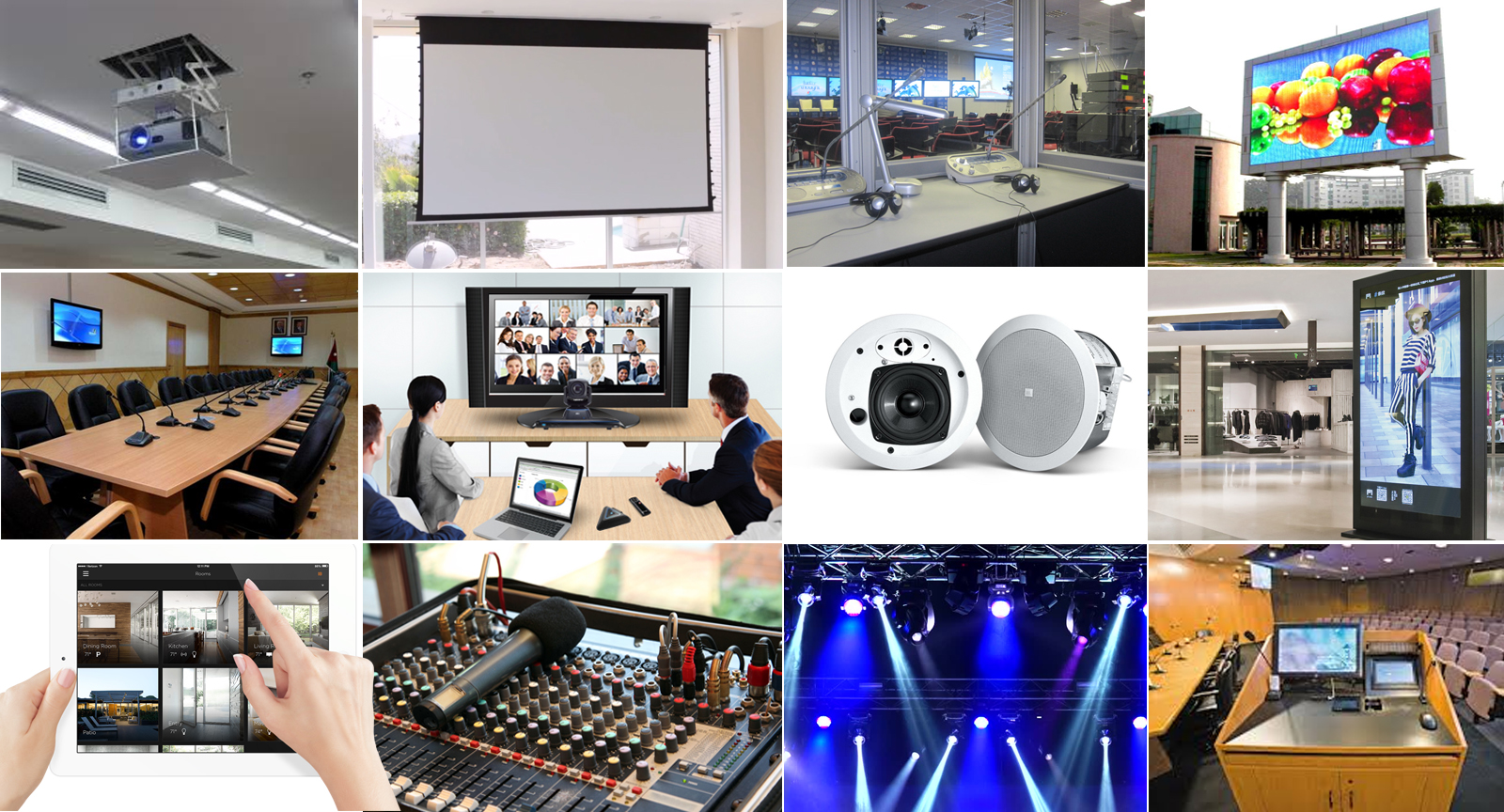How audio visual charlotte nc uses cutting-edge projection for stunning effects
Comprehending the Inclusion of Audio Visual Innovation in Today's Educational Environments
The assimilation of audio-visual innovation in academic settings has actually transformed the mentor and discovering procedure. Educators now have access to devices that accommodate numerous discovering styles, enhancing trainee involvement and cooperation. Nonetheless, the consolidation of these innovations presents both possibilities and challenges. Recognizing just how to successfully carry out these devices is important. What approaches can instructors employ to make best use of the advantages of audio-visual modern technology in their class?
The Evolution of Audio-Visual Innovation in Education
As academic demands evolved over the years, audio-visual technology undertook significant makeovers that reshaped the understanding setting. Initially, tools such as movie projectors and slide programs were the primary ways of integrating visual components into classrooms. These early technologies provided educators with the capacity to present information dynamically, yet they were limited in accessibility and interactivity.
With the development of videotape recorder in the 1970s, classrooms started to integrate recorded lessons, expanding the range of educational sources. The intro of desktop computers in the 1980s further revolutionized this landscape, permitting the creation of multimedia discussions and interactive learning experiences.
The increase of the web in the 1990s marked a turning point, allowing real-time access to a wide range of audio-visual materials. Today, electronic devices such as interactive white boards and online understanding platforms remain to enhance the academic experience, promoting involvement and partnership amongst students.
Advantages of Audio-Visual Tools for Diverse Knowing Styles
Audio-visual tools play a crucial function in dealing with diverse discovering designs by improving aesthetic knowing and enhancing auditory interaction. By incorporating pictures, video clips, and sound, these innovations create a more comprehensive instructional environment. This multifaceted strategy enables instructors to address the varied choices and needs of students efficiently.
Enhancing Visual Knowing
Engagement in the understanding process is noticeably enhanced via the usage of audio-visual devices, dealing with different discovering designs. These tools, such as videos, infographics, and interactive discussions, supply aesthetic stimuli that assist understanding and retention. Visual learners, specifically, gain from the consolidation of photos and animations, which can simplify complex ideas and improve understanding. Furthermore, audio-visual sources can highlight real-world applications, making finding out a lot more pertinent and appealing. By integrating color, activity, and noise, educators can create a dynamic understanding atmosphere that catches trainees' interest and fosters deeper cognitive connections. Eventually, the critical use audio-visual innovation not just supports visual knowing however additionally enhances the overall academic experience for diverse students.
Improving Auditory Interaction
A considerable advantage of including audio-visual tools in education is their capacity to improve auditory interaction amongst trainees. These tools, which encompass multimedia discussions, podcasts, and interactive audio components, satisfy numerous finding out designs, especially benefiting acoustic students (audio visual charlotte nc). By incorporating audio and narration, instructors can create immersive experiences that record students' focus and strengthen comprehension. This involvement is vital, as it promotes a much deeper understanding of the material and advertises retention. In addition, audio-visual devices can help with collective discovering atmospheres, motivating pupils to join conversations and share their insights. Eventually, the incorporation of audio-visual innovation not just supports acoustic engagement yet additionally improves the overall educational experience, making learning more dynamic and efficient for all trainees
Enhancing Involvement With Interactive Discovering

Moreover, gamification components, such as tests and simulations, can boost motivation and retention, making discovering more enjoyable and reliable. These strategies not just stimulate cognitive engagement but additionally cater to varied discovering designs, guaranteeing that all pupils can get involved meaningfully. As a result, interactive learning environments promote a sense of community and belonging, eventually causing enhanced academic end results. Through the integration of audio aesthetic modern technology, educators can transform traditional class into vibrant rooms where trainees flourish and proactively shape their academic journeys.
Connecting Theory and Exercise With Multimedia Resources
Multimedia resources offer as an important web link between academic concepts and practical application in educational settings. By boosting involvement, facilitating joint knowing experiences, and sustaining diverse learning styles, these tools create a more inclusive and vibrant learning environment - audio visual charlotte nc. This method not only cultivates deeper understanding but additionally prepares pupils for real-world challenges

Enhancing Interaction Via Multimedia
Involvement in academic setups substantially increases when instructors integrate multimedia sources right into their mentor approaches. Using videos, podcasts, and interactive presentations improves the discovering experience, enabling students to get in touch with the product on numerous degrees. Multimedia resources deal with various finding out designs, giving visual, auditory, and kinesthetic stimulations that can hold students' interest better than typical lecture approaches. Additionally, these resources can simplify complex concepts, making them more available and memorable. By integrating multimedia, instructors can create a vibrant class atmosphere that promotes inquisitiveness and encourages students. Ultimately, the strategic use audio-visual technology serves to bridge the gap in between academic knowledge and practical application, enriching the instructional experience for both teachers and trainees.
Facilitating Collaborative Knowing Knowledge
Countless studies indicate that collaborative discovering experiences considerably enhance pupil results when integrated with multimedia resources. Multimedia tools promote communication amongst trainees, enabling them to take part in analytical and vital assuming jointly. By using video conferencing, collaborative systems, and interactive presentations, instructors create atmospheres helpful to teamwork and shared learning. These modern technologies enable pupils to interact their ideas effectively and obtain immediate comments, fostering a much deeper understanding of the subject. On top of that, multimedia sources can offer complicated ideas in even more absorbable layouts, advertising conversation and collaboration. Therefore, the combination of joint knowing and audio-visual technology not just enriches the instructional experience yet also prepares trainees for real-world teamwork characteristics, emphasizing the importance of participation and cumulative expertise building and construction.
Sustaining Diverse Learning Styles
While traditional teaching methods often satisfy a minimal series of discovering preferences, the assimilation of audio-visual innovation provides a much more comprehensive method to education and learning. By employing multimedia resources such as video clips, interactive simulations, and digital presentations, teachers can address various learning styles, consisting of aesthetic, auditory, and kinesthetic. This flexibility permits for set apart instruction, allowing students to engage with content in manner ins which reverberate with their individual choices. Furthermore, audio-visual devices can facilitate much deeper understanding by providing several representations of complicated principles. Therefore, pupils that may battle with conventional techniques can discover alternative pathways to success, cultivating a more equitable discovering setting that supports scholastic success for all learners.
Challenges in Applying Audio-Visual Modern Technology
Audio-visual technology holds excellent promise for enhancing educational experiences, its application typically experiences considerable challenges. One main problem is the financial concern related to acquiring and maintaining such devices, which can stress budgets, particularly in underfunded establishments. In addition, inadequate training for educators can hinder here reliable combination, leaving them ill-prepared to use the modern technology fully. Technical problems, such as software application malfunctions and compatibility issues, may likewise disrupt lessons and frustrate both instructors and trainees. In addition, varying degrees of pupil access to innovation outside the classroom can develop disparities in finding out possibilities. The capacity for over-reliance on technology may take away from crucial training approaches, ultimately restricting the academic experience. Attending to these difficulties needs a thorough technique, including appropriate funding, professional advancement, and fair access to sources, to assure that audio-visual innovation can be leveraged effectively in today's academic setups.
Ideal Practices for Integrating Technology in the Classroom

Furthermore, fostering an interactive environment with collective devices encourages trainee interaction and engagement. Making use of diverse audio-visual sources satisfies numerous discovering designs, fitting aesthetic, auditory, and kinesthetic learners. On a regular basis evaluating the effect of innovation on pupil knowing assists instructors refine their methods and adapt to altering requirements. Entailing trainees in the selection of technology advertises ownership and inspiration. By sticking to these finest techniques, teachers can develop a vibrant classroom atmosphere that successfully integrates innovation and enhances the instructional experience for all pupils.
The Future of Audio-Visual Technology in Education
As class progressively embrace technology, the landscape of audio-visual devices in education remains to advance (audio visual charlotte nc). Future innovations are expected to concentrate on greater interactivity and customization, permitting teachers to customize finding out experiences to private pupil needs. Technologies such as augmented reality (AR) and online truth (VR) will likely provide immersive knowing environments, boosting trainee interaction and understanding
Fabricated intelligence (AI) is positioned to play a substantial duty in audio-visual technology by offering real-time feedback and flexible understanding paths. This assimilation may assist instructors identify and address pupil obstacles better. Cloud-based systems will certainly promote easier access to sources and collaboration among trainees and educators, despite place.
Along with these technical advancements, expert growth for instructors will certainly be essential, ensuring they are geared up to utilize these devices effectively. In general, the future of audio-visual modern technology in education assures to produce even more dynamic, comprehensive, and impactful understanding experiences.
Frequently Asked Inquiries
Exactly How Can Educators Pick the Right Audio-Visual Equipment for Their Classrooms?
Selecting suitable audio-visual devices calls for teachers to examine their instructional goals, take into consideration student demands, assess available modern technology, and seek recommendations from peers or specialists, making certain tools efficiently boost knowing and engagement within their details classroom environment.
What Budget Considerations Are There for Applying Audio-Visual Innovation?
Budget factors to consider for carrying out audio-visual technology include preliminary acquisition prices, upkeep expenditures, training for team, and potential software program licensing fees. Additionally, long-term financial investment in updates and substitutes must additionally be factored right into financial preparation.
Exist Certain Training Resources for Teachers on Audio-Visual Devices?
Numerous establishments offer training resources for teachers on audio-visual tools, including on the internet training courses, workshops, and instructional guides. These resources aim to improve instructors' abilities and self-confidence in efficiently integrating modern technology into their teaching techniques.
How Do We Measure the Efficiency of Audio-Visual Technology in Learning?
Gauging the performance of audio-visual modern technology in learning includes reviewing pupil engagement, comprehension, retention prices, and overall scholastic efficiency. Surveys, assessments, and observational researches can supply important understandings right into its effect on instructional outcomes.
What Prevail Mistaken Beliefs Concerning Audio-Visual Technology in Education And Learning?
Common false impressions regarding audio-visual technology in education include the idea that it assures interaction and discovering outcomes, in addition to the assumption that all trainees profit similarly, overlooking individual understanding choices and needs.